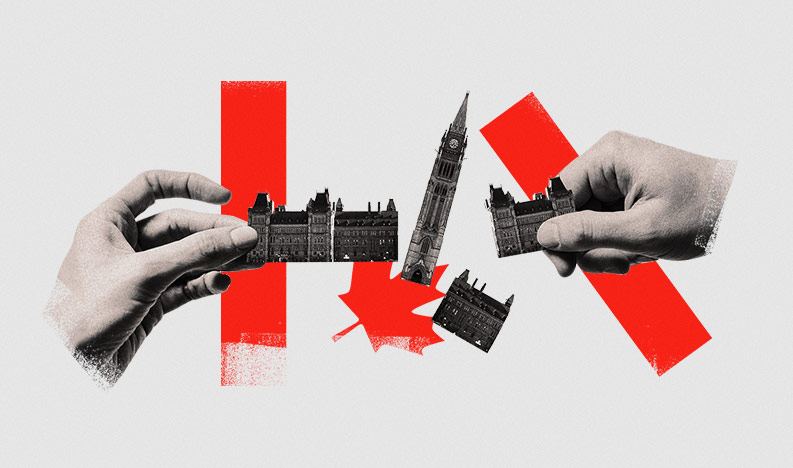Broken branches
Critics say that executive power in Ottawa has undermined the lawmaking process. Or is something else at play? Part 2 of our series on restoring trust in our legal institutions.

For a couple of decades now, there has been a growing sense that concentration of power in the Prime Minister's Office has accelerated the decline of influence of cabinet, ministers, and parliamentary committees in drafting policies and legislation. Should we worry?
"I don't know that the concentration of power thesis holds much anymore," says Lori Turnbull, director at the School of Public Administration at Dalhousie University, noting that the PMO functions differently from one government to the next. Former Prime minister Stephen Harper was known to be a control freak who insisted on approving everything. His successor, Justin Trudeau, doesn't have quite the same reputation. But despite his promise for a return to cabinet government in 2015, the calls are still growing seven years later to roll back centralized decision-making.
Though centralized and executive power may be no less prevalent under the Liberals than in the last Conservative government, there is something "different" in how prime ministers "wield power," says Turnbull. "This prime minister is very different than Harper." Who was different from his predecessors going back to the last government by cabinet under Lester B Pearson in the 1960s.
What's wrong with centralized power anyway? It erodes trust in a parliamentary system, goes the argument. And because parliamentary scrutiny is meant to produce better policymaking, our legislative process suffers. Add to that the public service's diminished policymaking role at the expense of a new political service class, and you end up with bills, such as Bill C-11, to modernize the Broadcasting Act, which get roundly criticized as inadequate and poorly drafted.
Indeed, critics worry that a pattern of sloppiness is settling into lawmaking. Over the past couple of parliaments, drafting errors in bills have been glossed over in the House of Commons, requiring amendments at the Senate. As it recently pushed pandemic legislation through Parliament, the government decided to forgo the amending process altogether, promising to include necessary changes in subsequent legislation instead. Call it the "fix-it-later" approach to lawmaking.
If the trend toward centralization has been under way for some time, it's been driven mainly by the reality that government programs and initiatives were getting increasingly complex. Rarely do issues today fall neatly under the purview of a single minister or department. Because of that, ministries must coordinate their efforts —though critics say that public servants in the Privy Council Office should be more involved, rather than the political staff in PMO.
Meanwhile, political power has become more concentrated in the offices of party leaders. Leaders have accumulated power within their parties at the expense of the elected caucus and grassroots membership, who no longer have an effective challenge function against their leadership.
Finally, Canadians have elected minority parliaments more frequently over the last two decades. So, a greater degree of centralization has been viewed as necessary to keep governments in power. Backbenchers tend to have a little more leeway and discretion during majority parliaments. Uniquely in the current Parliament, power dynamics are further driven by the confidence and supply agreement the Liberals struck with the NDP.
Among the leading observers of accelerated concentration of power in the PMO is University of Moncton professor Donald Savoie, who cautiously applauded the promise of returning to government by cabinet, provided a cultural change away from governing from the centre could effectively be carried out.
Turnbull finds Savoie's theory compelling and useful, but says it doesn't perfectly describe what's happening now, however difficult that may be to ascertain. "You get this sense [from Trudeau] that a lot of trust goes to the finance minister," says Turnbull. "Sometimes you don't hear a lot from the prime minister or the finance minister, and there's a sense of a vacuum there, where you're not sure what is going on."
Turnbull also notes that Trudeau has followed a pattern of choosing people he trusts and then pulling them into the senior ranks of the public service. By putting people in leadership positions, he sends a message about whom he trusts.
"It can send a message to the public service that there is a crossover between the prime minister's desire to work with the public service, but at the same time, bring in people he trusts to do things the way he wants," Turnbull says. "He's not just shuffling the deck chairs. To bring in people he has some relationship with gives the public service a responsiveness to him."
Layered on top of that is the occasional sense of confusion about where the current government is headed. Turnbull cites, for example, how Janice Charette, a Harper appointee, was shuffled out of her position as Clerk of the Privy Council in 2016, only to be returned a few years later.
Also, concerns remain about distrust between ministers and senior levels of the public service - something that critics say was exacerbated by the Federal Accountability Act, passed by Harper's government, and which many believe has deepened a culture of risk aversion within the bureaucracy.
Events, as always, have also played a part in this government's approach to dealing with the public service. During the pandemic, says Turnbull, "files just got cast aside because everything that wasn't COVID couldn't be prioritized. The whole relationship with the public service has been disrupted by that."
Jennifer Robson, the program director of the graduate program in political management at Carleton University, says she senses that this government has reverted to dynamics that were the focus of criticism of the Harper government - running all decisions through the PMO first. When the green light is finally given, often late, the delay causes more problems.
"You can only be a highly centralized, controlling PMO if you're also highly efficient and organized," Robson says. "You've got this problem of bottlenecks, and that need to have eyes on everything implies that you don't trust the rest of your team. In terms of the trust in the public service in 2015, I think that was always lip service, a postural difference vis-à-vis the Conservatives, who had been actively beating up on the public service."
Robson heard the complaints early in the Trudeau era about the shape of the public service, and that the relationship quickly broke down.
"If you have a lot of people around the table who hadn't been in federal government before, there can be a sense that they didn't realize that this is how they run things," Robson says. "There are definite exceptions—I am aware of a number of political staffers and ministers who have been able to create really good, collaborative, respectful relationships with their public servants."
The past as we remember it
Philippe Lagassé, the Barton Chair at the Norman Patterson School of International Affairs at Carleton University, who studies executive power in Westminster democracies, is skeptical there is an identifiable problem around legislating today.
"What are we comparing it to?" Lagassé asks. “Where's the evidence of a fundamental shift that points to centralization as the culprit? There may be issues around vetting legislation, which has more to do with scheduling sitting days and with parliamentarians wanting to do their jobs.”
"Are we identifying the right factor?" Lagassé asks. "Is it that legislation is getting worse, or is the legislation getting more complex? I think there's something to be said about the individual departments and ministers managing their portfolios putting things up and getting the centre to sign off on things—that's probably true. It's probably becoming more difficult," he says.
Lagassé then points to national security overhauls, or recent legislation around cyber issues as "not insignificant" legislative achievements. "And yet they have happened," he says. "Also, so much of the nation's business is provincial in orientation, and yet there's an expectation of positive legislation, and maybe the legislation wasn't great because we were expecting the legislative narrative to be legislation for the sake of legislation."
Lagassé also cautions against the propensity of today's pundits to over-embellish the legislation of the past.
"Think back to patriation and the kind of dog's breakfast that ended up being the amending formula," Lagassé says. "It's not like we are wonderful crafters of law at all times."
One former senior public servant, who spoke on a not-for-attribution basis, suggests that part of the problem at the Department of Justice may be that there aren't any Mary Dawsons around, referring to the woman who served as the director of legislative drafting in the department until her retirement in 2005. Described as a logician in the department, Dawson had a reputation for skillfully forcing public servants to be rigorous in their thinking. She was especially effective at ensuring coherence and consistency in the drafting of bills.
We can't assume everyone involved in the process has that talent, and yet it's one that seems elementally important. Consider the recent emergency legislation passed early in the pandemic. Lawyers who studied the bill initially seemed as if each section had been drafted separately and sewn together. Sunset clauses did not line up and even relied on separate mechanisms for no apparent reason.
Turnbull says that ministers should value the public service's challenge function on legislation and its advice to avoid getting into a jam later. "Especially given the precarity of the parliamentary situation at this point. They don't have a majority."
According to Robson, much of the legislative drafting these days is rushed. During the early pandemic, for example, there wasn't enough attention paid to defining the Canada Emergency Response Benefit, or CERB. That created problems for people making claims.
"Some of it is circumstances that are out of your control—we didn't predict the pandemic, fine," Robson says. "Some of it feels like a bit of an own-goal," citing the insistence on approving everything and the recurring bottlenecks caused at the top. "[If] you have views that you want to input into stuff—if you're only ever doing that at 11:59 PM, then you're constantly re-creating rush and crisis."
Perceived problems also depend on external variables, outside of the executive and the legislative purview, says Lagassé. If the courts are more frequently declaring legislation invalid, it's worth asking whether that's a reflection of the legislation or whether the courts are becoming more aggressive. And how do the executive and Parliament view their role in relation to what the courts say? "If they have to do something, then they'll do it, but if the courts are handling a lot of it, great," Lagassé says. "Is it centralization, or the judicial involvement in the lawmaking process?"
An illustration of that is the initial medical assistance in dying legislation. Ministers shepherding the bill through Parliament were warned, particularly by the Senate, that it would not meet the standard set by the Supreme Court of Canada. Yet both Jane Philpott and Jody Wilson-Raybould went ahead. A Quebec Court ruled against them months later.
Turnbull notes that early on, Trudeau's government placed much trust in those two ministers. They were jointly responsible for several big files, including MAiD and cannabis legalization.
"Now they're both gone, and you see Trudeau flat-footed, to be honest," Turnbull said. "A lot of ministers he trusted as his star people to get things moved are gone. It doesn't mean that he's got nobody left, but some of the people wearing all that front-bench work are no longer present."
Another factor to consider in the lawmaking process is the erosion of the independence of parliamentary committees. This has happened in a couple of ways in the House of Commons. During the Harper years, parliamentary secretaries to ministers sat on committees in a voting capacity and directed government MPs to vote in specific ways. The complaint was that it turned committees into branch plants of ministers' offices, rather than holding them to account.
After Trudeau formed government in 2015, the membership on committees fell from 12 MPs to 10, and parliamentary secretaries could attend only in a non-voting capacity. But the number of committee members rose again to 12 MPs when Canadians elected a minority parliament in 2019. Because the government needed to fill seats, parliamentary secretaries were once again on board as voting members.
During the pandemic, as Parliament began sitting in a hybrid fashion, limited IT resources and interpretation staff meant fewer committee hearings. Disagreements played out into filibusters that would last for weeks, all of which had a detrimental effect on the committees' ability to scrutinize legislation.
Over in the Senate, committees that were once feared and respected by senior public servants have largely evaporated. A dispute between the Independent Senators Group and other groups in the Red Chamber after the 2019 election, mostly over the rules around the portability of committee seats, which led to a months-long standoff, and almost no committees formed until the 2021 election. By that time, the resource-sharing agreement with the House of Commons meant that the Commons had priority over IT and interpretation resources. Most Senate committees were cancelled. Legislation would get rushed through with little attention, save a few speeches in the Senate Chamber and possibly the appearance of the minister to answer questions.
The incentives for MPs have also changed when it comes to their work. Many of them have surrendered swaths of their responsibilities to independent Officers of Parliament, such as the Parliamentary Budget Officer, whose word largely goes unquestioned by parliamentarians and the media alike. Much of the substantive debate in the House of Commons has instead focused on point-scoring to generate clips for social media channels.
Leo Groarke, president of Trent University, is one of the partners with the Jarislowsky Foundation's new pan-Canadian academic network on trust and political leadership.
"This project is a response to a very polarized time," Groarke explains. "Everybody seems to agree that things are not working well, and in that context, people don't trust what politicians are doing. Every side points the finger at somebody else, and I think the feeling shared by everyone in this project is that political discourse has become finger-pointing."
"The right way to make laws is to have civil discourse, where we have rational disagreements and work out our differences," he says. "Maybe [we] have pragmatic compromises, and that requires that we get along with one another." Descending into name-calling hardly creates the environment one needs to have a productive debate, he says.
Groarke says the research network is looking into what is driving polarization and explore possible remedies.
Trust in institutions can fluctuate over time, but it's harder to regain it when it's been lost, which is why Robson regrets the opportunity we had during the early days of the pandemic. At the time, there was a massive spike in public trust in government, public health experts and institutions.
"The resources of the state were marshalled quickly and visibly, and for a time, people felt like it made a meaningful difference in their lives," she says. "Over time, that trust has been eroded. We have really, truly squandered something in a big way, and it would be harder for the institutions of the state to repeat what they did because of that loss."


